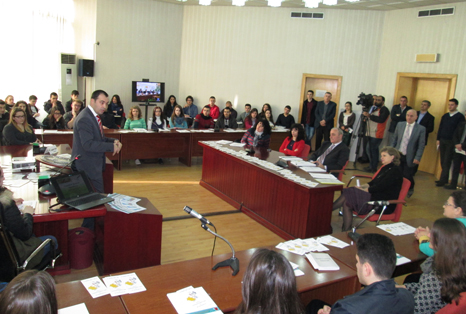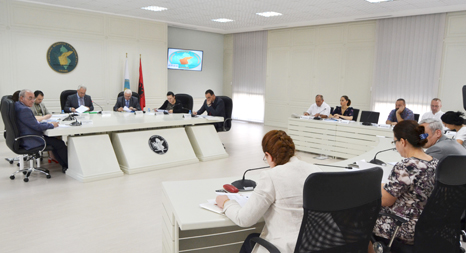
Clarification for the public opinion
The CEC, pursuant to the provisions of article 119 and 120 of the Electoral Code, shall immediately publish in the CEC website the result of each voting center once they are officially received by the CEAZ. In the above provisions, even though the legislation stipulates that the data published by the CEC are official data, it provides that at the time of their publication, it must be specified that the results are preliminary ones.
In order to meet this obligation, CEC, in its Instruction no. 1/2015 “On the collection, administration and publication of the preliminary election results” has defined the procedures followed by the CEAZ and CEC for the collection, administration and publication of the preliminary election results. According to this Instruction, issued pursuant to the Electoral Code, electronic information reporting from the CEAZ to the CEC starts after the receipt of electoral material by the VCC, followed by the electronic delivery of the tabulation of results of the Voting Center and concludes with the reporting of the aggregate table of results issued by the CEAZ.
For the purpose of publication of preliminary election results, information technology equipment is installed in all BCCs, which enables online communication from CEAZs with the CEC server.
The CEC has used the BCC-CEC module in implementation of CEC Instruction No. 1, dated 20.02.2015 “On the Collection, Administration and Publication of the Preliminary Election Results”, which was also applied in June 30, 2019 election to publish in the media room monitors, on the official website of the CEC, the dynamics of the preliminary results of election in the election zone level.
The Electoral Code does not specify in any of its provisions the CEC responsibility to release information on election participation during the voting day.
Even though such obligation is not explicitly stated in the Electoral Code, the CEC, in order to respect the public opinion and public interest, and increase the transparency of the electoral process, provides information on the voting participation during the Election Day
Information on voting turnout during election day is provided by the Secretary of the Voting Center, according to the provisions of Article 12 of the CEC Instruction no. 2/2015 “On the organization and functioning of the Voting Center Commission”. This provision of the CEC normative act defines one of the duties of the VCC Secretariat to notify the CEAZs every three hours after the opening of the voting, the number of voters who have voted up to that moment and after the closing of the voting, to notify the CEAZ of the total number of voters who have voted and their gender.
Regarding the information reported by the CEAZs to the CEC on voters turnout through mobile phone by the VCCs, where for objective reasons, such as the missing signal for certain geographical areas, lack of communication by secretaries VCs, -under no circumstances can we pretend a maximal accuracy.
Also, we should consider the fact that the voter list is administered by the VCC Chairman, while the data is transmitted by the VCC secretary, who, by does not have the available (voter list) where the number of voters is identified by the signatures, he reports the data on voters turnout based on the notes he has taken- thus it becomes evident that the figure reported by the VCC Secretary cannot have a maximum accuracy.
In addition, even in the information received by the CEAZs and reported by the CEC after 19.00, the data referred are not final.The Voting Centers close at 19.00 or beyond that hour due to reasons provided for in the Electoral Code. Only after the closing of the voting, the Voting Center Commission carries out the procedures for release of the data, including the number of voters who voted and their recording in the record kept by the CEC according to article 113 procedures of the Electoral Code.
So, even at 19:00, when the VCC secretary does the last reporting through the mobile phone, he does not have the exact data on the number of voters who have participated in the voting, because the Chairman of the VCC, under observation of all VCC members and observers, has not yet completed the process to determine the number of voters who voted based on their signatures on the voter list and in the Special Voters Register.
The way of reporting information from the CEAZ to the CEC on election day voting is not regulated by normative acts of the CEC. In 2015 local government elections, the CEC through the individual decision, Decision no. 13/2015 “On Approval of Procedures for the Collection, Administration and Publication of Information on Election Day on Elections for Local Government Elections 2015” defined the process how the Secretary of the VCC will fulfill its duty provided in the above normative act: It will notify the respective CEAZ every three hours, after 7:00 pm of the opening of the ballot, and after the closing of the voting on the number of voters who have voted , reporting the data via mobile phone, while reporting of information from the CEAZs to the CEC would be made electronically via through the network which connects the BCCs with the CEC server.
Any interested party can easily verify on the official website of the CEC that the information published by the CEC on the voting turnout during the election day, even in the previous elections is named “voter turnout from the voting centers which have reported data”.
Reporting of information from CEAZs to the CEC on the voting through mobile phones was also used in the previous elections in the absence of a module for reporting it. In 2015 local elections, 2017 parliamentary elections,by- elections of 2013, 2016, 2017, the transmission of information on voting participation by CEAZs to the CEC was done by reporting via email, as well as through the mobile phone when the CEAZs failed to send information electronically due to workload or even negligence.
The large volume of information of the elections process is administered by the CEC through the Integrated System of Election Information Electronic Management (IEMIS), which is operating since 2009. The system has been integrated and received preliminary information at BCC-CEC level .
For each elections process, as well as June 30th, 2019 elections, the CEC administration officials were engaged in establishing communication with the CEAZs during the voting day, in order to provide real-time information on the opening of voting, disruption and resumption of voting, issues with election materials, as well as information on voting participation.
Concerning the above, the reporting of information on voting participation during election day by telephone is not a method chosen for these elections only, is the method used in all elections by the election administration, starting from the Voting Center Commission to the CEAZs further by the CEAZ to the CEC. It refers to preliminary data, does not include information from all Voting Centers, and for these reasons we cannot claim its accuracy. For example, in 2017 elections, data published by the CEC on voters turnout at 10:00 referred to reports from 25% of VCs; at 13:00, reports coming from 26.37% of VCs, at 16:00, reports of 11.30% of VCs, and at 19:00, reports of 19% of VCs.
Regarding the above, even in the elections of June 30,2019,just like in the previous elections, the publication of data by the CEC on the voters’ participation in elections referred to data which cannot be considered final official data of voters participation as in every elections they are considered preliminary information and they did not match with the official data available in the single official election documentation: the records filled at the end of the voting.
We hope that this public clarification will convince you that the alleged inconsistencies are made in the context of unfounded and deliberate allegations, since the CEC has emphasized, the data on voting participation were preliminary, therefore “inaccurate” as in the previous elections, which can be easily proved on the CEC official site but also on media shooting, despite the fact that too much focus on that issue in these elections for reasons which go beyond the nature, mission and work of the CEC.








